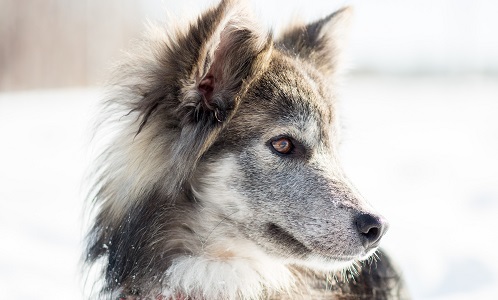If you feel your dog has experienced tracheal collapse, you are likely wondering, “How did this happen?”
It’s a scary situation, and this article is here provide information that helps ease the process.
First, we’ll confirm what the trachea is, the types of dogs most susceptible to tracheal collapse and the reasons it occurs.
Please remember that all information shared is what can often lead to tracheal collapse, however, each pup and situation is unique. If you do suspect tracheal collapse but have not taken your pup in yet, consult with your veterinary professional as soon as possible.
What is the Trachea? How Does It Collapse?
The Trachea brings air from the throat and nose into the body, connecting it to the lungs. It is also known as “the windpipe”.
To be candid, the term collapse may sound incredibly frightening and traumatizing. Tracheal collapse may not be reversible, but there can be possible ways to help your pup. It is something to be taken very seriously, but know there are potential solutions to help your dog find relief.
The trachea itself is a tube and has C-shaped rings along the entire length. These rings keep the tube upright and strong, allowing the air to flow in like children zipping down a tubular slide. If the cartilage becomes weaker or was affected at birth already, these critical rings can flatten. Without that necessary support, the trachea begins to close in, like sides of a straw being drawn inward and together. If that straw becomes more and more closed, the air is increasingly more difficult to bring through.
 Not only does it affect the windpipe, though. This collapse can reach the bronchi, which help propel air into your pup’s lungs. Each of these factors can decrease the ability of your dog to breathe well and strong.
Not only does it affect the windpipe, though. This collapse can reach the bronchi, which help propel air into your pup’s lungs. Each of these factors can decrease the ability of your dog to breathe well and strong.
The root of the issue, no matter these other factors, tends to be those weakened C shaped rings.
Now, there are a few breeds that are more likely to have this happen.
What Dog is Most Likely to Have Tracheal Collapse?
Some breeds of dog are more susceptible to a windpipe collapsing. Often it is the toy breeds, such as:
- Miniature poodle
- Yorkshire terrier
- Shih tzu
- Lhasa apso
- Chihuahua
- Pug
- Pomeranian
- Other small breeds
It is not limited to the breeds, however, if you have one of these types of pups, know that the risk and likelihood are higher.
How Can I Tell if My Dog Has it?
Some dogs may have been prone to this condition for a long time, however, not yet showed signs of collapse. When the windpipe issue begins to reveal itself, the most telltale sign is typically a harsh, very dry-sounding cough. Many vets refer to the sound like a goose honk. When dogs get highly excited, experience pressure on their throat from a leash or have just eaten or lapped up water, the sound often gets worse. Something as simple as picking them up, even gently and lovingly, can have a cough-inducing effect on their trachea.
If you notice your pup’s gums turning blue, you need to act fast. If they are losing so much air that there’s blue color, there is a problem. At that point, it is critical to go seek medical attention as soon as possible.
What Causes the Collapse?
As with most conditions or medical situations, there is a myriad of possibilities. Potential causes include:
- A chronic condition from birth, such as weak cartilage within the trachea
- Being overweight
- Not sure if your dog is at the right weight or getting enough exercise?
Find out if your dog is active enough at this quiz.
- Not sure if your dog is at the right weight or getting enough exercise?
- Poor nutrition
- A respiratory infection
- An obstruction of the windpipe
- A house with smoking as smoke is more likely to aggravate the clinical symptoms
 One problem is that once a dog starts having difficulty breathing from a collapsed trachea, they are likely to get anxious, feel nervous and start panting. This rapid, shallow breathing can further aggravate the problem. That is why it is important to know how to calm anxiety in your dog.
One problem is that once a dog starts having difficulty breathing from a collapsed trachea, they are likely to get anxious, feel nervous and start panting. This rapid, shallow breathing can further aggravate the problem. That is why it is important to know how to calm anxiety in your dog.
Here is something else important to know.
Although other conditions may not be the root cause, it is common for dogs that come into the vet with tracheal collapse to be experiencing other medical conditions, as well. Often, a dog with this windpipe issue also has a heart condition. (With the collapsed trachea making difficult more breathing, it can lead to problems with the heart.)
How Old Are Dogs With Tracheal Collapse?
Usually, tracheal collapse occurs when a dog is middle-aged or later in life, typically ages 4 – 14. Some sources cite a more specific average age of age 6 or 7.
Think Your Dog May Have this Condition?
After reading this, you may have the gut-wrenching suspicion that this is what your dog is experiencing. To provide more information that helps you understand the possibilities and feel ready to enter the veterinarian’s office, please review the Treatment for Tracheal Collapse in Dogs.
Sources:
“Tracheal Collapse .” ACVS, Accessed 13 Oct. 2018. www.acvs.org/small-animal/tracheal-collapse.
“Collapse of the Wind Pipe in Dogs.” PetMD, Accessed 13 Oct. 2018. www.petmd.com/dog/conditions/respiratory/c_dg_tracheal_collapse#.
Kuehn, Ned. “Tracheal Collapse in Dogs – Dog Owners.” Merck Veterinary Manual, Accessed 13 Oct. 2018. www.merckvetmanual.com/dog-owners/lung-and-airway-disorders-of-dogs/tracheal-collapse-in-dogs.



